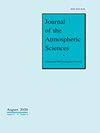Onset of Tropical Cyclone Rapid Intensification: Evaluating the response to Length Scales of Sea Surface Temperature Anomalies.
IF 2.8
3区 地球科学
Q2 METEOROLOGY & ATMOSPHERIC SCIENCES
引用次数: 0
Abstract
Predicting the rapid intensification (> 15.0 m s−1 increase in 10m wind speed over 24 hours or less) of tropical cyclones (TC) remains a challenge in the broader context of numerical weather prediction largely due to their multiscale dynamics. Ocean observations show that the size and magnitude of sea surface temperature (SST) anomalies associated with cold wakes and ocean eddies play important roles in TC dynamics. In this study, a combination of spectral and structure function analyses is utilized to generate realistic realizations of multiscale anomalies characteristic of the SST conditions in which Hurricane Irma (2017) underwent rapid intensification (RI). We investigate the impact of the length scale of these SST anomalies and the role of translation speed on the variance in RI onset timing. Length-scale-induced convective asymmetries, in addition to the mean magnitude of SST anomalies beneath the storm eye, are shown to modulate the variance in RI onset timing. The size of the associated SST length scales relative to the storm size is critical to the magnitude of variance in RI onset timing, as smaller length scales are shown to lack the spatial extent required to induce preferential convective asymmetries. Stormtranslation speed is also shown to influence the variance in RI onset timing for larger length scale ensembles by altering the exposure time of the eye to these SST anomalies. We find that an interplay between SST-induced convective asymmetries, the magnitude of SST anomalies underneath the eye/eye-wall, and storm translation speed play crucial roles in modulating the variance in RI onset timing.热带气旋快速增强的爆发:评估对海面温度异常长度尺度的响应。
在更广泛的数值天气预测背景下,预测热带气旋(TC)的快速增强(24小时或更短时间内10米风速增加>15.0米s−1)仍然是一个挑战,这主要是由于其多尺度动力学。海洋观测表明,与冷尾流和海洋涡旋相关的海面温度异常的大小和幅度在TC动力学中起着重要作用。在这项研究中,结合光谱和结构函数分析,生成了飓风Irma(2017)经历快速增强(RI)的SST条件的多尺度异常特征的实现。我们研究了这些SST异常的长度尺度的影响以及翻译速度对RI发病时间变化的作用。除了风暴眼附近SST异常的平均幅度外,长度尺度引起的对流不对称性也调节了RI开始时间的变化。相关SST长度尺度相对于风暴大小的大小对RI开始时间的变化幅度至关重要,因为较小的长度尺度缺乏诱导参考对流不对称所需的空间范围。风暴平移速度也被证明通过改变眼睛对SST异常的暴露时间来影响较大长度尺度系综的RI开始时间的变化。我们发现,SST引起的对流不对称性、眼/眼壁下SST异常的程度和风暴平移速度之间的相互作用在调节RI开始时间的变化方面起着关键作用。
本文章由计算机程序翻译,如有差异,请以英文原文为准。
求助全文
约1分钟内获得全文
求助全文
来源期刊

Journal of the Atmospheric Sciences
地学-气象与大气科学
CiteScore
0.20
自引率
22.60%
发文量
196
审稿时长
3-6 weeks
期刊介绍:
The Journal of the Atmospheric Sciences (JAS) publishes basic research related to the physics, dynamics, and chemistry of the atmosphere of Earth and other planets, with emphasis on the quantitative and deductive aspects of the subject.
The links provide detailed information for readers, authors, reviewers, and those who wish to submit a manuscript for consideration.
 求助内容:
求助内容: 应助结果提醒方式:
应助结果提醒方式:


